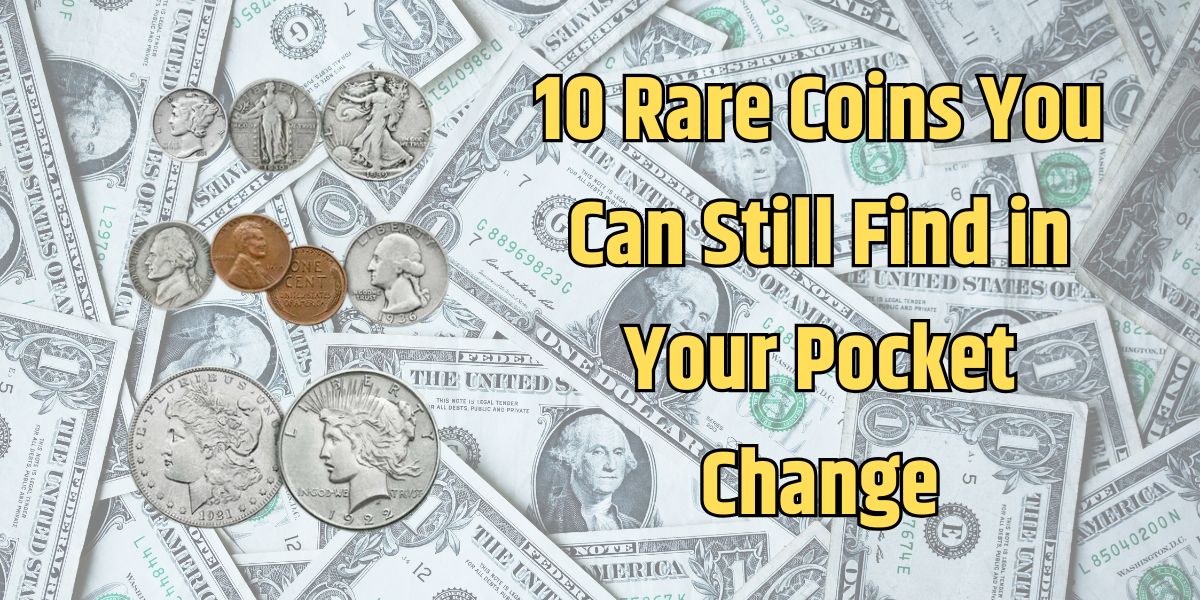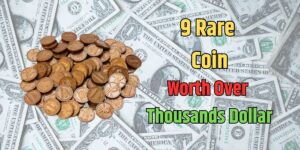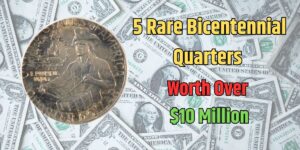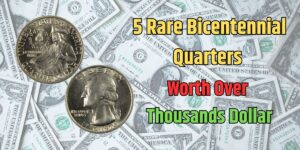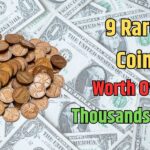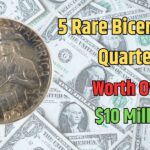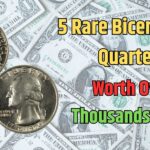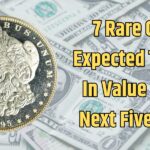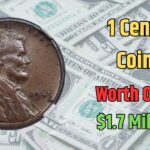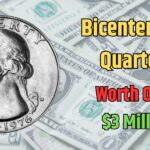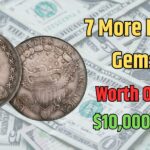If you’ve ever wondered whether there’s a hidden treasure in your pocket change, the answer might surprise you. Many U.S. error coins and rare varieties are still in circulation, waiting to be discovered. These coins feature subtle yet valuable errors such as doubled dies, missing mint marks, or unique lettering, making them worth far more than their face value.
This guide highlights 10 valuable coins you can still find in circulation, with tips on how to identify them and their approximate value. With the right tools, a sharp eye, and some patience, you could uncover a small fortune hidden in plain sight!
1. 1969-S Lincoln Cent With Doubled Die Obverse
:max_bytes(150000):strip_icc():format(webp)/1969-S_doubled_die_penny_HA-56a1773c5f9b58b7d0bf8ea1.jpg)
The 1969-S Lincoln Cent is a legendary error coin, featuring dramatic doubling on the obverse (heads side). Early discoveries caused confusion, with the Secret Service initially confiscating some as counterfeits until the U.S. Mint verified their authenticity.
- How to Detect: Look for clear doubling on the date and LIBERTY, but ensure the mint mark “S” is not doubled (this would indicate strike doubling, which holds little value).
- Approximate Value: $40,000 or more in AU-50 or higher grades.
2. 1970-S Small Date Lincoln Cent With Doubled Die Obverse
:max_bytes(150000):strip_icc():format(webp)/US0001-1970-S-Dbl-Die-Lincoln-Cent-5660ecca5f9b583386bf11af.jpg)
This rare variety is distinguished by its Small Date and prominent doubling on LIBERTY and IN GOD WE TRUST.
- How to Detect: Look at the 7 in the date. On the Small Date variety, the 7 aligns evenly with the other numerals. If the 7 is lower, it’s the common Large Date variety. Check for doubling on the letters.
- Approximate Value: $3,500 in EF-40 condition.
3. 1972 Lincoln Cent With Doubled Die Obverse
:max_bytes(150000):strip_icc():format(webp)/US0001-1972-Dbl-Die-Lincoln-Cent-56a177a93df78cf7726aefaa.jpg)
The 1972 Doubled Die Lincoln Cent is easily identified by strong doubling on the coin’s obverse. This coin remains popular among collectors.
- How to Detect: Look for doubling on the date, LIBERTY, and IN GOD WE TRUST. A die gouge near the “D” in UNITED on the reverse is a common marker. Use at least a 6x magnifying glass for verification.
- Approximate Value: $500 or more in EF-40 condition.
4. 2004-D Wisconsin State Quarter With Extra Leaf
:max_bytes(150000):strip_icc():format(webp)/US0025-50-State-Quarter-2004-Wisconsin-Extra-Leaf-3x2-5660edfa3df78cedb0afcd99.jpg)
This Wisconsin State Quarter features an unusual extra leaf on the ear of corn, which is highly visible without magnification.
- How to Detect: On the reverse, check for an additional leaf on the left side of the corn. There are two variations: High-Leaf and Low-Leaf errors.
- Approximate Value: $200 to $300 in MS-60 condition.
5. 1999 Wide “AM” Reverse Lincoln Cent
:max_bytes(150000):strip_icc():format(webp)/US0001-1999-Wide-AM-Close-Up-5660efe25f9b583386bf2c12.jpg)
The 1999 Wide AM variety occurred when the Mint accidentally used a proof die for standard circulation coins.
- How to Detect: Look at the reverse. In the Wide AM variety, the letters A and M in AMERICA are clearly separated. In the standard version, they are very close or touching.
- Approximate Value: $75 to $600 in MS-63 or higher, depending on color. Circulated coins can fetch $5 to $25.
6. 1982 No Mint Mark Roosevelt Dime
:max_bytes(150000):strip_icc():format(webp)/US0010-Roosevelt-Dime-1982-No-P-obv-5660f1955f9b583386bf32ac.jpg)
In 1982, some dimes were accidentally struck without a mint mark, making them highly sought after by collectors.
- How to Detect: Check the obverse side of the dime for a missing mint mark (“P” for Philadelphia). If no letter appears, you’ve found the rare variety.
- Approximate Value: $30 to $50 in AU-50, with higher grades commanding more.
7. Presidential Dollar Edge Lettering Errors
:max_bytes(150000):strip_icc():format(webp)/Washington_Dollar_Error_no_edge_lettering-500-56a1775b3df78cf7726aebde.jpg)
The Presidential Dollar series, launched in 2007, featured edge lettering with inscriptions. Some coins, however, have errors where the edge lettering is missing, doubled, or inverted.
- How to Detect: Inspect the edge of the coin. Missing inscriptions or doubled lettering signify a valuable error.
- Approximate Value: $50 to $3,000, depending on the President and condition.
8. 1995 Doubled Die Obverse Lincoln Cent
:max_bytes(150000):strip_icc():format(webp)/US0001-1995-Dbl-Die-obv-Lincoln-Cent-Liberty-5660f2d23df78cedb0afe0a5.jpg)
The 1995 Doubled Die Lincoln Cent is a more modern example of a doubled die error and remains relatively easy to find.
- How to Detect: Look for clear doubling in the inscriptions LIBERTY and IN GOD WE TRUST. This error is visible without magnification.
- Approximate Value: $20 to $40 in uncirculated condition.
9. Certain Uncirculated State Quarters
:max_bytes(150000):strip_icc():format(webp)/US0025-50-State-Quarter-Program-rec-56a177e13df78cf7726af259.jpg)
Uncirculated rolls of specific State Quarters can command a premium, particularly for in-demand states like Georgia, Connecticut, Tennessee, and Illinois.
- How to Detect: Rolls must contain strictly uncirculated quarters. Look for bright, untouched coins with no wear.
- Approximate Value: $20 to $52 per roll depending on the state.
10. Silver Half Dollars (1965–1970)
:max_bytes(150000):strip_icc():format(webp)/US0050-Kennedy-Franklin-Half-Dollar-obv-original-56a177ca3df78cf7726af104.jpg)
Many people assume silver was removed from all U.S. coins in 1964, but Half Dollars minted from 1965 to 1970 still contain 40% silver.
- How to Detect: Check the coin’s date:
- Halves dated 1964 or earlier contain 90% silver.
- Halves dated 1965 to 1970 contain 40% silver.
- Look at the coin’s edge—silver coins lack the copper stripe seen on modern coins.
- Approximate Value: Varies based on the spot price of silver.
Final Tips for Finding Rare Coins
- Invest in Tools: Use a magnifying glass (6x or higher), good lighting, and a digital scale to inspect coins.
- Learn the Signs: Study errors like doubling, missing mint marks, or off-center designs.
- Check Your Change: Regularly inspect coins you receive from banks, stores, or coin rolls.
- Stay Informed: Reference coin guides like the Cherrypicker’s Guide and follow market trends.
- Verify Authenticity: If you suspect a valuable coin, have it authenticated by professional grading services like PCGS or NGC.
Final Thoughts
Finding rare coins in your pocket change isn’t just about luck—it’s about knowing what to look for. With the right tools and knowledge, you can uncover error coins, doubled dies, and silver pieces worth far more than their face value. So start checking your change—you never know when you might stumble upon a hidden treasure!
FAQs
What are the most valuable coins in circulation?
Key examples include the 1969-S Doubled Die Cent, 2004-D Wisconsin Quarter (Extra Leaf), and 1982 No Mint Mark Dime.
How do I identify a doubled die error?
Look for clear doubling on letters, numbers, or design features. Use magnification for precise detection.
Are silver coins still found in circulation?
Yes! Half Dollars from 1965–1970 and occasional older dimes or quarters may still appear in pocket change.
What should I do if I find a rare coin?
Have it authenticated by a trusted numismatic service, then consider selling it through certified dealers or auctions.
Where can I learn more about rare coins?
Resources like the Cherrypicker’s Guide, professional coin websites, and forums are excellent for further education.
